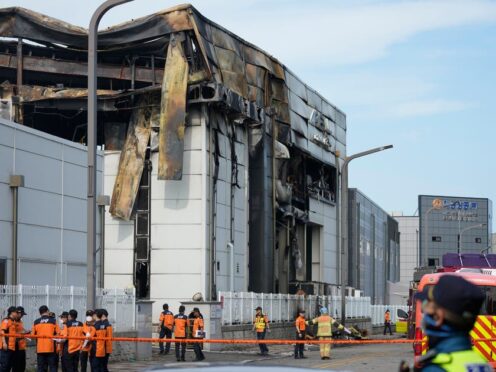
Forensic and other experts were combing through the charred ruins of a factory building near South Korea’s capital on Tuesday to find the cause of a devastating fire that killed 23 people, mostly Chinese migrant workers, in one of the country’s deadliest blazes in years.
More than 100 people were working at the factory in Hwaseong city, just south of Seoul, when the fire tore through it on Monday morning.
Security cameras showed smoke engulfing the second floor of the factory, soon after sparks were detected from a site where lithium batteries were stored, fire officials said.
One victim was pronounced dead at a hospital, and fire workers retrieved 21 bodies from the factory during Monday. An additional body was recovered on Tuesday.

Eighteen victims were Chinese, two were South Korean and one was Laotian. The nationalities of the other two dead were being verified.
Many Chinese people, including ethnic Koreans, have migrated to South Korea to find jobs since China and South Korea established diplomatic ties in 1992.
Like other migrant laborers from Southeast Asian countries, they often work in factories, construction sites and restaurants, engaging in the so-called “difficult, dangerous and dirty” jobs that are shunned by more affluent South Koreans.
Chinese Ambassador Xing Haiming visited the factory site on Monday night and reportedly expressed condolences to the victims.

Police were extracting DNA samples from the bodies and their potential relatives to confirm their identities, according to fire officials.
One factory worker remained out of contact, but officials said the body discovered on Tuesday is likely to be that person.
Eight others were injured, with two of them in a serious condition.
In a Cabinet Council meeting on Tuesday, Prime Minister Han Duck-soo instructed officials to provide support to bereaved families over funerals and compensation issues.
He also asked for safety inspections on industrial sites.
During a visit to the site on Monday, President Yoon Suk Yeol ordered officials to put in place measures to effectively deal with battery-related fires.

On Tuesday, more than 50 fire officers, aided by two rescue dogs and other equipment, were mobilised to continue searching the burned factory, local fire official Kim Jin-young told a briefing.
A separate team of 40 forensic, fire, police and other officials examined the site later on Tuesday to investigate what exactly caused the blaze.
Labour officials said the government will separately investigate whether any safety issues were involved in the fire. The factory is owned by battery manufacturer Aricell.
In a televised conference near the fire site on Tuesday, Aricell chief Park Soon-kwan offered a public apology over the blaze.
After deeply bowing with other company officials, he said he would offer all available assistance to bereaved families and faithfully undergo government investigations over the blaze.
Most of the dead workers were daily labourers so they were unlikely to be familiar with the building’s internal structure, senior fire officer Jo Seon-ho told reporters on Monday.
He said video of the fire site showed they rushed to an area where there was no exit after failing to put out the blaze with fire extinguishers. He said the victims are likely to have inhaled toxic smoke.

Rechargeable lithium-ion batteries are ubiquitous in consumer goods from laptops to mobile phones. They can overheat if damaged, defective or packaged improperly, leading to fires and explosions and making them a hazard for shipment on board aircraft.
Monday’s blaze was one of the deadliest in South Korea in recent years.
In 2020, a fire at a warehouse being built in Icheon City, south of Seoul, killed 38 construction workers.
In 2018, 46 people died after a fire ripped through a small hospital with no sprinkler systems in the southern city of Miryang.
In 2008, 40 workers, 12 of them ethnic Koreans with Chinese nationality, died after a fire and accompanying explosions tore through a refrigerated warehouse in Icheon city.
South Korea has struggled for decades to improve safety standards and change widespread attitudes that regard safety as subservient to economic progress and convenience.

Enjoy the convenience of having The Sunday Post delivered as a digital ePaper straight to your smartphone, tablet or computer.
Subscribe for only £5.49 a month and enjoy all the benefits of the printed paper as a digital replica.
Subscribe